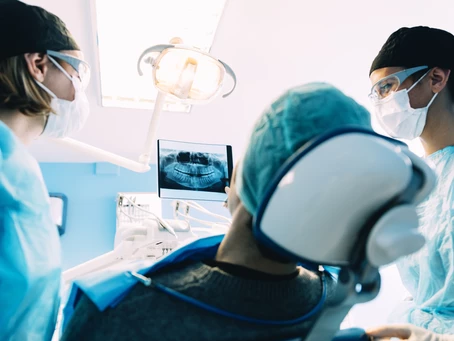Before we jump into the services and procedures an oral surgeon provides, let’s briefly discuss the specialty of oral surgery and how one becomes an oral surgeon.
Technically termed, oral and maxillofacial surgeons are specialists who have undergone 4 to 6 years of additional schooling in a hospital-based residency program after completion of dental school. These further years of training enable oral surgeons to treat ailments relating to the hard and soft tissues of the face, mouth, and jaws. Oral surgeons also excel in placing dental implants and performing several reconstructive surgeries of the face.
Oral surgeons spend their residency learning the intricate details and surgeries involving the maxilla (upper jaw), mandible (lower jaw), and nasal cavity. They also gain knowledge and expertise in internal medicine, anesthesiology, and otolaryngology (ear, nose, and throat). Apart from this, they also are trained to perform oral plastic surgery and therapy. Oral surgeons are experts in diagnosing and treating all sorts of issues related to the jaws and facial region.
This blog will talk about some of the most common oral surgical procedures provided by an oral and maxillofacial surgeon.
Dental Implants
Dental implants are screw-shaped surgical fixtures that are placed into the jawbone via an incision on the gums. Placement of a dental implant is an oral surgery procedure that seamlessly and elegantly replaces missing teeth. Dental implants can replace a single tooth and even the entire dentition.
Getting dental implants starts with an oral surgery consultation, during which our oral surgeon will conduct a thorough oral examination. They will analyze the number of missing teeth, the bone quality of the intended area and may also take some x-rays. After careful consideration, our oral surgeon will advise you on your custom treatment plan.
The process of placing a dental implant starts with the administration of local anesthesia. After this, an oral surgeon will make a tiny incision on the gum area. The gums are reflected, the underlying bone is exposed, and then a series of specialized dental implant drills are used to create a hole for implant placement. Once the implant is placed, the separated gums are brought back to their position; the surgical site is sutured and allowed to heal.
Dental implants are left to integrate with the jawbone over 3-6 months. During this phase, you will be scheduled for timely appointments, which will ensure the health and success of your dental implant treatment. Once the implants are firm and one with the jawbone, they act as a foundation for placing dental crowns, dental bridges, and even dentures.
This rehabilitative oral surgical procedure allows optimum restoration of chewing capabilities, speech and also rejuvenates your smile.
Bone grafting
Bone grafting comes under minor oral surgery procedures and is carried out when there is a lack of adequate jawbone. For example, a bone grafting procedure is routinely carried out before dental implant placement to ensure adequate bone height and width. Bone grafting also helps to reconstruct the jawbone after it has been compromised due to gum diseases.
Oral surgeons can take the help of autograft (your bone), allograft (bone obtained from another human being), allopast (synthetic bone graft), or xenograft (animal bone graft) to regenerate the lost bone.
Sinus Lift
Sinus lift or sinus augmentation is an oral surgery procedure that is done to make more space for the formation of a new bone. A sinus lift is usually done to make enough room for dental implant placement as, without it, the dental implant may fail to integrate. It is carried out when there is a lack of adequate jawbone in the maxillary region to place a dental implant.
Once a proper amount of anesthesia is achieved, an oral surgeon will start the oral surgery by making two incisions on the back portion of the upper gums. The bone and sinus floor are exposed to reach the sinus membrane. Next, the membrane is gently lifted, and a bone graft is applied, followed by the closure of the surgical site via sutures.
Tooth Extractions
Tooth extraction is one of the most common oral surgery procedure done throughout the world. Teeth are routinely extracted when involved in dental decay, gum diseases, and even orthodontic purposes. Tooth extraction is also done under local anesthesia with the help of forceps and dental elevators.
Wisdom Teeth Removal
Wisdom teeth or third molars are notorious for their erratic eruption patterns and the pain when they become impacted or infected. Unlike normal tooth extractions, wisdom teeth removal tends to be a little more complex and needs a greater level of skills and expertise, which an oral surgeon possesses. Wisdom teeth removal is generally carried out under local anesthesia; however, our surgeon may advise general anesthesia in complex cases.
The process starts with our surgeon making an incision around the offending tooth. The gums are reflected, and the jawbone is exposed. If the wisdom tooth is impacted in the jawbone, some bone will be removed with the help of specialized dental instruments and drills. In more straightforward cases, the tooth may come out entirely, or it may even have to be removed in sections. Once the tooth is removed, our surgeon will check the area to ensure complete tooth removal. The incised gums are closed with the help of the sutures.
If you think you may need a dental implant, a tooth removal, or even a jawbone fracture repair, consult our board-certified oral surgeon today. If you have any more questions or would like to know more about our services, reach out to us, and our team of excellent dental professionals will be there to assist you.


